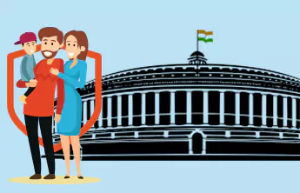India's Insurance Sector Growth Story Economic Survey 2022-23
Blog Title
1782 |
The government came out with its latest economic survey on January 31, 2023. Economic Survey 2022-23 also gave an outlook of the life insurance sector across India over the past year. According to the survey, India is expected to be one of the top six insurance markets by 2032. What’s surprising to note is that many Indians view life insurance as a means for future savings rather than protection. Will discuss more about this later.
But first, if you are someone who isn’t aware what Economic Survey is, read on.
What is Economic Survey?
The Economic Survey is a report that analyses the current economic performance and trends in India and is presented in Parliament before the Budget. It provides insight into the allocation of resources and the mobilization of resources in the Union Budget. The Survey covers various economic factors such as agricultural and industrial production, infrastructure, employment, money supply, prices, imports, exports, foreign exchange reserves, etc.
The Budget, being a statement of government policy, reflects and shapes the economy, and is grouped into economic magnitudes for better understanding of government receipts and expenditure's impact on different sectors.
The survey estimated India's Gross Domestic Product (GDP) growth for the fiscal year 24 to be 6.5 percent, while the growth for the current fiscal year is projected at 7 percent, compared to 8.7 percent in the previous fiscal year 22.
Key Highlights of the Economic Survey 2022-23
Below are the key highlights of the 2022-23 Economic Survey regarding improvements in the life insurance sector.
- The survey reveals that the insurance penetration rate in India has risen steadily from 2.7% in 2000s to 4.2% in 2020 and remained unchanged in 2021.
- The life insurance penetration rate in India was 3.2% in 2021, which is almost twice that of emerging markets and slightly higher than the global average.
- However, the survey also points out that the majority of life insurance products sold in India have a savings component with only a minimal protection aspect.
- Life insurance penetration in India grew from US$11.1 in 2001 to US$91 in 2021, reflecting the rapid growth of the insurance industry in the country, with a density of US$69 in 2021.
Let’s look at the above highlights from the survey in detail for better understanding.
- Increase in Insurance Penetration: Insurance penetration is characterized by two metrics: insurance penetration and insurance density. Insurance penetration measures the proportion of insurance premiums to the Gross Domestic Product (GDP), while insurance density is the ratio of insurance premium to the population. The survey highlights that insurance penetration in India has increased from 3.69% in 2018 to 4.57% in 2022. This increase can be attributed to the growth of the insurance sector, which has been fuelled by the rise of digitalization and increased awareness about insurance among the population.
By providing convenient and accessible insurance options, online insurance companies have made it easier for people to protect their futures and grow their wealth. Online platforms offer an array of insurance products, making it easier for individuals to compare and choose the best coverage to meet their needs. The result is a growing demand for insurance services, particularly in the life insurance sector, which has benefited from the rise of online players like Edelweiss Tokio Life Insurance.
- Growth of the Life Insurance Sector: The life insurance sector has been growing rapidly, with a growth rate of 12.5% in 2022. This growth can be attributed to the increasing demand for insurance products among the population, especially in rural areas. The growth of the life insurance sector can also be attributed to the introduction of new age products like ULIPs (Unit Linked Insurance Plans), Endowment Plans, Retirement Plans, Guaranteed Income Plans and more. These products cater to the changing needs and expectations of customers, offering a range of benefits such as flexibility, customized coverage, and market-linked returns. As a result, they have become increasingly popular and have driven the growth of the life insurance sector, attracting a growing number of customers looking to secure their financial future.
- Growth of Micro-Insurance: The survey highlights that the micro-insurance sector has seen significant growth in recent years, with the number of people covered under micro-insurance increasing from 20% in 2018 to 28% in 2022. This growth can be attributed to the increasing demand for insurance products among the low-income population and the government's efforts to increase financial inclusion.
Micro insurance is specially designed for low-income individuals and families who may not have access to traditional insurance options. It provides a range of insurance products such as health, life, and property insurance, with coverage amounts and premiums tailored to meet the financial capabilities of low-income households. The aim of micro insurance is to provide access to insurance services to people who may not have the resources to purchase comprehensive coverage, helping to protect them against financial risks and promoting financial stability and security.
- Increase in Insurance Awareness: The survey highlights that there has been an increase in insurance awareness among the population, with more people realizing the importance of insurance in securing their financial future. This has been fuelled by government initiatives and the rise of digitalization, which has made it easier for people to access information about insurance products and services. One such initiative being Sabse Pehle Life Insurance, a comprehensive insurance awareness initiative launched by the Insurance Regulatory and Development Authority of India (IRDAI). The goal of the initiative is to educate the public about the importance of life insurance and encourage them to buy coverage to protect themselves and their families.
As a part of the initiative, IRDAI has undertaken a wide range of activities to raise awareness about life insurance and its benefits. This includes working with insurance companies and industry stakeholders, conducting public seminars and workshops, and leveraging various media platforms such as radio, TV, and social media to spread the message. It is an important step in addressing the gap in insurance coverage in India. IRDAI's efforts to raise awareness about life insurance and its benefits will help to educate people about the importance of securing their financial future and encourage them to take the necessary steps to protect themselves and their families.
- Prioritizing saving over protection: As highlighted above, penetration of life insurance in India has increased but there is a cold nudge when it comes to protection.Indians tend to prioritize saving over protection when purchasing life insurance, due to a variety of factors. One of the main reasons is a lack of awareness about the benefits of life insurance, which results in it not being considered a priority. Additionally, India has a strong culture of saving, and life insurance policies are often viewed as a way to save money for the future rather than as a means of protection. Despite these challenges, life insurance has been growing in popularity in India in recent years, as people become more aware of its benefits and the industry improves its reputation.
However, one must note that Term insurance policies are typically much less expensive than guaranteed income plans, making them more accessible to a wider range of people. Overall, term insurance policies are a simpler and more straightforward form of life insurance that can provide peace of mind and financial security to policyholders and their families at a lower cost.
In conclusion, India has the potential to become one of the top six insurance markets by 2032. However, there is still a gap in the market when it comes to securing loved ones financially. Many Indians view life insurance as a means for future savings rather than protection, which can result in negative consequences, such as financial insecurity and poverty in the event of an unexpected loss or another pandemic like COVID-19.
To address this gap, it is important to learn more about the benefits of protection products. Edelweiss Tokio Life Insurance offers customized protection products and leverages technology to reach a wider audience. The company is committed to promoting financial stability and security for individuals and families in India.
Source:
https://www.indiabudget.gov.in/economicsurvey/ebook_es2022/index.html
Neha Panchal - Financial Content Writer
Neha used to be an Engineer by Profession and Writer by passion, which is until she started pursuing full-time writing. She's presently working as a Financial Content Writer, with a keen interest in all things related to the Insurance Sector.












